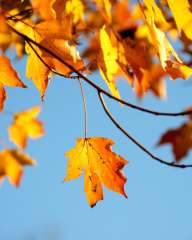Why Yellow Jackets are Aggressive in Autumn
Why Yellow Jackets are Aggressive in Autumn
Yellow Jackets are predatory social insects native to North America. They have distinct yellow and black stripes and are often confused with honey bees. They are actually wasps that have the typical thin waist and can sting multiple times.
Many people see these insects as a nuisance. They can be particularly annoying during the warmer months when you are enjoying the hot sunny weather. They eat sweets and sugar, so that means they will most likely crash your barbeque or outdoor party from a nearby colony.
Yellow Jackets eat other insects too. They are often seen by scientists and environmentalists as beneficial predators of insects and pests. Insects, meat, and other proteins are consumed by the larvae which produces sugar for adult yellow jackets.
Aggression in Autumn
Despite their benefits to agriculture, many people find them to be a nuisance. They have a painful sting and they also exhibit aggressive behavior especially during the fall.
Why are they aggressive during as winter approaches? These wasps are social insects living in colonies consisting of workers, drones, and queens. It starts when the queen starts a colony in the warmer months. She feeds the larvae with insects and other proteins until mid-summer when the first workers emerge.
The adult Yellow Jacket consumes foods rich in sugar and carbohydrates. Towards the fall, the number of larvae decreases and the demand for sugar for the adult wasps increase. They then begin to forage for sweets, sweet fruits, and sodas at picnics.
The sudden down surge in sources of sugar makes the Yellow Jacket particularly territorial and aggressive during late summer and fall. At this point, not only are there no larvae to produce sugar, but there is a short supply of fresh fruit and rotting meat. They have no choice but to aggressively search for food as winter approaches.
Habitat and Behavior
Yellow Jackets live mainly in the Northern regions of the United States. The cold winter creates an environment that makes it hard for them to survive. Their colonies are annual and most die or disintegrate during or just before winter.
However, these wasps can build nests in hidden and relatively secure places. You could have a Yellow Jacket colony in a corner of your house hidden in the cracks on the wall. They don’t often reuse the nest after winter. But if they find a warm stable location to hide their nest, they can build a colony with multiple queens. Such colonies can grow up to 10 square feet in size with more than 5,000 Yellow Jackets.
Caution and Removal
Some wasps may be beneficial to agriculture and the ecosystem, but around your home they can be a risk to your loved ones and friends. You can avoid them by properly putting away trash during autumn and summer. This is when they are looking for sugar and carbohydrates. Close the trash bin and avoid open containers.
If there is already a colony, do not try to remove them by yourself. Unlike bees, they can sting multiple times. If you have an allergy, the Yellow Jackets stings could be fatal. Also in late summer or fall, they are more willing to attack pets, children and neighbors. Get a professional team to locate the colony and safely eradicate the problem once and for all.


